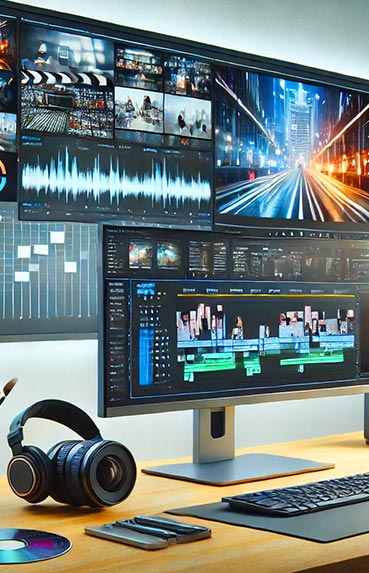In today's digital era, video content has become a fundamental tool for communicating and connecting with global audiences. However, not all videos manage to capture the audience's attention, and the quality of editing plays a crucial role in this aspect. As technology advances, so do viewers' expectations, making video editing an art and a science that requires skill, creativity, and precision. In this article, we will explore video editing techniques that can significantly enhance the quality of your online videos, helping you stand out in a saturated market.
Understanding the Importance of Video Editing
Editing as a Narrative
Video editing is not just a technical process; it is a way to tell a story. How shots are assembled, timing is adjusted, and visual and sound elements are integrated can transform a simple video into an emotional and immersive experience.
- Building the narrative: Editing allows for the creation of a coherent and engaging narrative. By meticulously selecting and organizing scenes, the editor has the power to guide the viewer's attention and evoke certain emotions.
- Emotional impact: Through the use of transitions, sound effects, and music, editing can intensify the emotional impact of the content. A study from New York University found that appropriate use of music can increase viewers' emotional engagement by up to 30%.
The Role of Editing in Visual Quality
Visual quality is a crucial component in the overall perception of a video. Good editing can enhance visual quality in several ways:
- Color correction: Adjusting the colors of a scene to be consistent and aesthetically pleasing can make a video look more professional. Tools like Adobe Premiere Pro and DaVinci Resolve offer advanced color correction options that can completely transform a video's appearance.
- Image stabilization: Shaky footage can distract and disorient viewers. Video stabilization is an essential technique that can turn a shaky shot into a smooth and stable image.
Essential Video Editing Techniques
Effective Use of Transitions
Transitions are a powerful tool for maintaining the flow and rhythm of a video. However, they should be used sparingly and with purpose.
- Direct cuts: These are the most basic transitions and are used to switch from one shot to another without effects. They are effective for maintaining a fast and fluid pace.
- Fades: Used to indicate a change in time or place, fades can smooth the transition between scenes and give a sense of continuity.
- Creative transitions: Effects like wipes, swipes, or fade to black can add a stylistic touch but should be used carefully to avoid distracting the viewer.
Color Correction and Grading
Color correction and grading are essential techniques for creating a visual atmosphere and unifying the look of a video.
- Color correction: Involves adjusting white balance, exposure, and contrast so that images are consistent and realistic.
- Color grading: Refers to applying a specific visual style, such as a cinematic look. Color grading can be used to evoke certain emotions and enhance the visual narrative.
Integration of Visual Effects
Visual effects can enrich a video and make it more engaging, but they should be integrated subtly and appropriately.
- Motion effects: Adding movement to graphic or text elements can capture the viewer's attention and guide their gaze.
- Special effects: From simple filters to complex 3D effects, these can enhance a video's visual impact. However, they should be used sparingly to avoid overwhelming the image.
Proper integration of visual effects can make the difference between an amateur and a professional video.
Enhancing Audio Quality
Importance of Audio in Video
Audio is often an underestimated aspect of video production, but it is as important as the image. Clear and well-mixed audio can significantly improve a video's quality.
- Sound quality: A study from Stanford University showed that viewers are more likely to abandon a video with poor sound than one with poor image quality.
- Audio and video synchronization: Ensuring that audio is perfectly synchronized with the video is crucial for maintaining viewer attention and avoiding distractions.
Audio Editing Techniques
Audio editing includes several techniques that can improve the auditory experience of a video.
- Noise reduction: Using audio editing software like Audacity or Adobe Audition to eliminate background noise and enhance sound clarity.
- Equalization: Adjusting audio frequencies so that all elements, such as voices and music, are clear and balanced.
- Audio compression: Helps level sound volume, ensuring that peaks are not too high and softer moments are audible.
Incorporating Graphic Elements
Use of Graphics and Text
Graphic elements and text can enrich the information presented in a video, making the content easier to understand.
- Text overlays: Adding titles, subtitles, or explanatory graphics can help emphasize key points and make information more accessible.
- Animated graphics: Using moving graphics to explain complex concepts or maintain viewer interest.
Consistency in Visual Style
Maintaining a consistent visual style is essential for brand identity and video cohesion.
- Color palette: Choosing a color palette that aligns with the brand or video theme.
- Typography: Using consistent fonts for all text elements to maintain a professional and uniform appearance.
Optimizing Videos for Online Platforms
Adapting to Different Formats
Different platforms have specific requirements for video uploads, and adapting content to these formats can improve playback quality and reach.
- Aspect ratio: Ensuring the video is in the correct format for the platform, such as 16:9 for YouTube or 1:1 for Instagram.
- Resolution: Exporting the video in the highest resolution possible allowed by the platform, such as 1080p or 4K, to ensure the best image quality.
Considerations for Online Distribution
The way videos are distributed online can influence their performance and visibility.
- SEO optimization: Including relevant keywords in the video's title, description, and tags to improve its search engine ranking.
- Attractive thumbnails: Creating thumbnails that capture the user's attention and encourage them to click on the video.
Conclusions
Video editing is a complex process that requires a combination of technical and creative skills. By mastering editing techniques such as effective use of transitions, color correction, audio enhancement, and incorporating graphic elements, you can elevate the quality of your online videos and ensure that your content is not only seen but also remembered. With growing competition in the digital space, attention to detail in editing can be the key to standing out and connecting with your audience meaningfully.

















